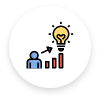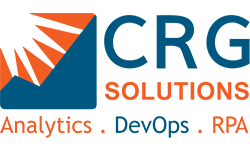
Approach
Oldcastle is North America’s leading manufacturer of building products and materials like masonry and hardscapes, also known as “sexy concrete.” With 20 divisions and 206 facilities across Canada and the United States, Oldcastle first found success with Tableau by turning a 500-page monthly report into a governed, enterprise-wide accessible dashboard for their employees. Ian Crabtree, Chief Financial Officer of Oldcastle Masonry & Hardscapes, was initially skeptical of business intelligence solutions. But at Ian’s behest, the company now touts more than 3000 dashboards and 1800 dashboard subscribers, tracking 78,000 SKUs. Oldcastle’s business intelligence team leads the charge by working with IT to adequately provide governance and security and helping enable smart and rapid business decisions in their competitive industry.

Problem Statement
Ian Crabtree, Oldcastle’s CFO of Masonry & Hardscapes, once appropriately equated the size of the company’s monthly report as “the size of a paver you’d put in your backyard.”
When Ian first hired Paul Lisborg, Manager of Business Intelligence at Oldcastle, he tasked his new employee to replace the 45-page PDF that arrived in people’s inboxes every morning.
It showed the most recent sales numbers by divisions, by business line, and by facility. But due to the static nature of PDFs, numbers were often outdated soon after publishing.
With Tableau, Paul created a dashboard that provides a digestible overview of Oldcastle’s 206 distinct manufacturing facilities and allows employees to ask follow-up questions. The dashboard is refreshed every night so the data stays fresh. It also has row-level security, meaning teams only see data they have permission to view.
Once people realized they could ask their own questions of the data, the response was almost immediate.
“We started getting phone calls: ‘Can you add this filter?’ ‘I want to see the data in this fashion,” says Paul.
It was clear people wanted to see the data in their own ways. So Paul, with the help of several analysts, created a library of templates containing vetted data. Using web authoring, people can use these vizzes as a starting point for their own analysis and share their findings.
“We can give them a data set with predefined measures and dimensions, and they can build their own intelligence through the web-authoring tool. And it’s one single source of truth,” says Paul. “Whether a gentleman builds it in San Diego or a lady builds the same information in Chicago, they’ll be getting the same answer, but at the same time, they can manipulate the data to their specific needs.”

Tracking 78,000 SKUs across 206 facilities
The Oldcastle sales team spearheads an inventory of over 78,000 stock-keeping units (SKUs). It’s imperative for the team to quickly and easily identify losses, track margins, and seize potential opportunities across their enterprise. But empowering a sales force in a scalable way proved difficult. Now, by pulling ERP and Salesforce data into Tableau, the sales team always has access to the full picture.
“Now a sales rep can come into a dashboard, look to what he sold yesterday, look to how he’s doing this month, look how he’s doing year to date. And then he’s able to drill down into: What customers are doing well? What are those customers buying? What are my margins on those items?” says Paul.
Everyone from sales managers to individual sales representatives look to Tableau dashboards to track quotas on a daily and monthly basis. For a sales team, having access to insights from the vast quantities of customer data is empowering.
“Now, [a salesperson has] Tableau dashboards. They might not even be aware they’re looking at a Tableau dashboard. But the information that they are receiving from that is much more powerful than having rows and columns of information,” says Paul.
CFO champions 360-degree view of the business
As Oldcastle’s CFO, Ian describes the role of finance as the “heartbeat of a company.” He says, “It’s connected to sales, it’s connected to logistics, procurement, production, marketing.”
When Ian first trialed Tableau, he knew that it would change the way that the company consumed data and he felt compelled to champion it across the business. “Very quickly, I could see that that this was a disruptive technology that’s going to take time to embrace, but once it becomes a fabric of the company, is going to change the way that we consume data.”
Today, in meetings and day-to-day work, Oldcastle’s leadership team uses Tableau to see a 360-degree view of the business in real time. Ian can convey financial information in an easy-to-consume format, helping leaders make informed, data-driven decisions based on current data.
“A better CFO, for me, is being a true business partner to the business president,” shares Ian. “My favorite part of my job is sitting at the leadership table and bringing insight to the management group and bringing it in real time—proposing something to [improve operations.]
“In my role in finance, especially with tools like Tableau, I can do that far quicker, cheaper, faster, and in so doing, I get a kick. I help the business be more successful.”
Mold-tracking dashboard
Oldcastle’s 11 divisions share concrete molds on a national scale. One of Paul’s first projects with Tableau was creating a mold-tracking visualization to give instant visibility into a mold’s location for manufacturing productivity.
Instead of creating a new mold for a manufacturing project, Oldcastle’s sister companies can reference the dashboard to find the location of one nearby–saving resources and expediting manufacturing timelines.
“[The visualization] went from zero to 60 overnight,” says Paul. “We have about 200 production people that are looking at it all at the same time.”
IT and BI teams work together to enable 1,800 users
IT teams across organizations, including Oldcastle’s, are the brain trust when it comes to keeping data secure. For Ian and Paul, it was incredibly important to collaborate on a workflow that would help propel fast business decisions for the organization at-large.
“We have both SQL Servers and a Netezza data warehouse. They maintain the infrastructure, the security. And we work with them to produce the data models and dashboards,” says Paul.
Oldcastle pulls ERP data from its Netezza warehouse and creates a daily extract on Tableau Server. The company also pulls SQL tables from Salesforce and creates extracts to get quick insights into customer leads and opportunities.
Across the enterprise, Oldcastle has more than 500 web authors and some 1,800 dashboard subscribers—and growing.
With IT providing proper governance, everyone, from division presidents to manufacturing workers, is empowered to uncover insights and make an impact.
“This is a true culture of self-service analytics,” says Ian.

Leave a Comments
You must be logged in to post a comment.